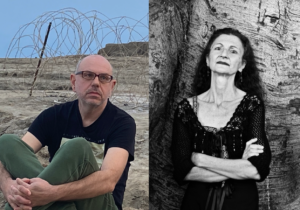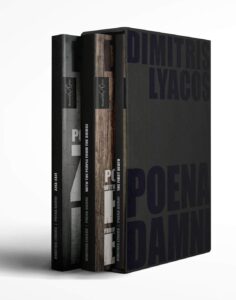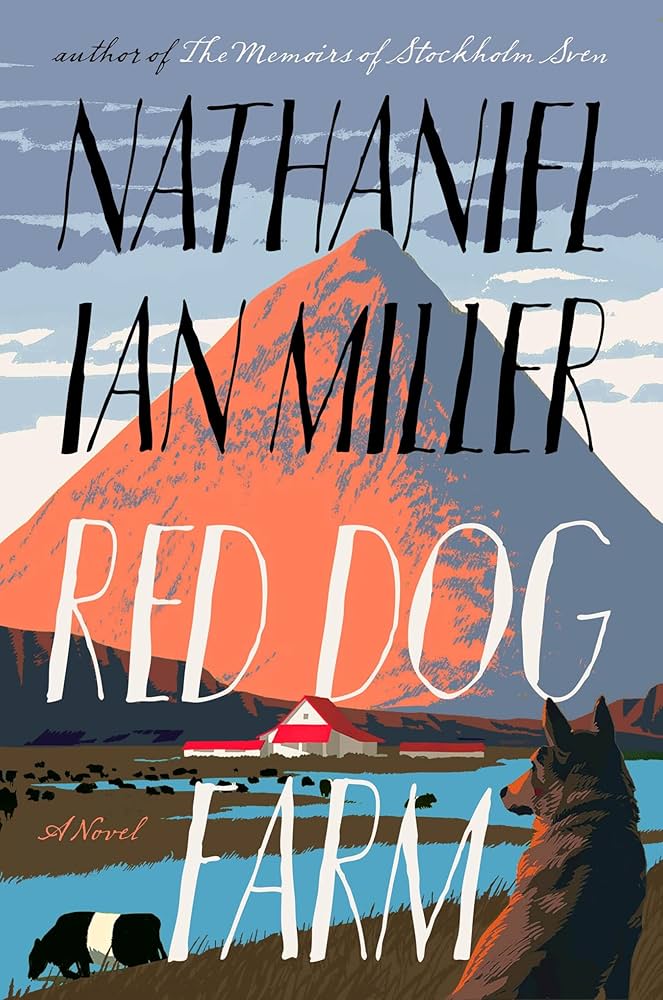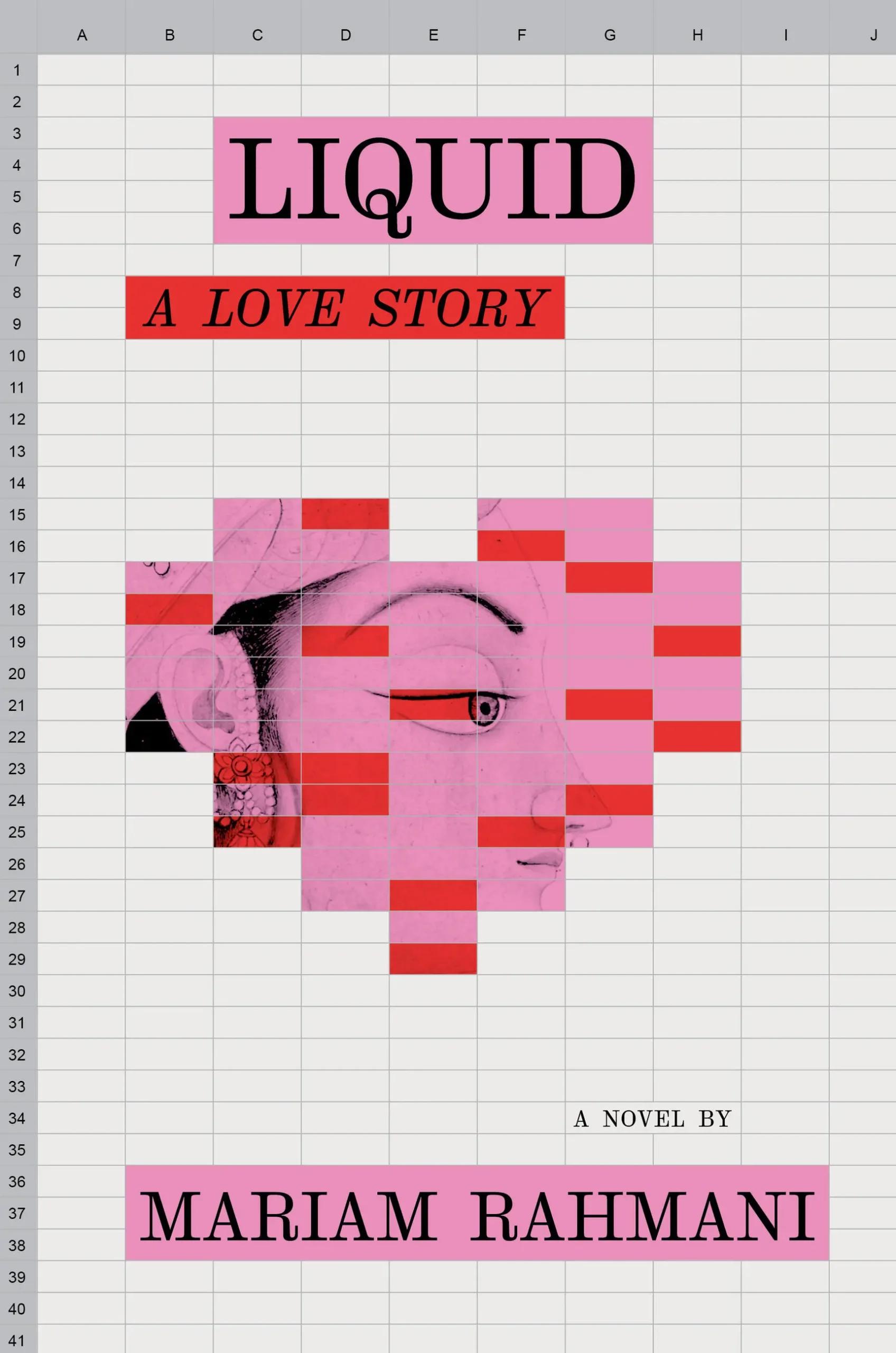
DIMITRIS LYACOS describes his new book, Until the Victim Becomes our Own, as a prequel to his world-renowned trilogy, Poena Damni—which begins with a fugitive on a train, but never clarifies what, whom, and where from he has fled, hinting at the past only through the traces it left, showing us a mere geography of scars. Until the Victim Becomes our Own reels us back to the pre-fugue universe, mapping both an archeological grid and a bird’s-eye view of our very own Western civilization, founded on Judeo-Christian traditions, then evolved through industrialization and capitalism up to the digitally-global present day.
Though he was bound to Israel when TOTI O’BRIEN reached out to him with her questions, Lyacos agreed to interweave their conversation with his travels, and we are glad he did.
Toti O’Brien: The society you evoke through the alternating voices of its leaders and sufferers is mainly ruled by violence—a controversial concept, discrepantly defined from different points of view. Only in the ’60s, for instance, have we started to discuss institutional, or even psychological, violence. Rivers of ink were spilled on the subject, and yet they have hardly impressed the common mentality. A store window broken during a riot is still deemed more violent than the centuries of abuse leading to it. Your new book explores the dialectic of visible and invisible violence—of physical aggression versus hidden manipulation—in its intimate folds. In your terms, what is violence, when stripped of its chameleonic attires? How do you define it?
Dimitris Lyacos: Causing harm by the exercise of force might be an adequate definition. However, while violence is mostly associated with physical force, force doesn’t always have to be accompanied by some form of action. Intentional neglect, refraining from action, may be just as damaging. Think of Tantalus’s punishment: he was placed in a pool from which he could not drink, and the fruit tree above his head “tantalized him,” moving out of his grasp every time he tried to reach it. There was no physical force acting against him, nature simply avoided him as if it were conscious of his infraction. This isn’t just mythology. Think of the lack of access that individuals or groups of lower social status experience in contemporary societies: our spectacular supermarkets, our malls, are no places for the poor and the needy—in fact, they may feel as inaccessible to them as the great halls of castles felt to the serfs who worked its fief. Our socioeconomic systems always presuppose some form of exclusion; lack of access to commodities might be their most benign expression. Exclusion remains an archetypal form of violence since biblical times: the Lord does not respond by using physical violence against Cain after he has murdered his brother; he “deprives him of his presence”—a kind of Poena Damni, as the title of the trilogy has it, which means the privation of the vision of God, the denial of “paternal help,” fall from grace: abandonment in an adverse world, what a heartless parent would do to his child. One might think these are human inventions, but they also appear in the animal world—albinism-related ostracism has been observed among catfish. Also, Jane Goodall has spoken of immigrant and diseased individuals being shunned in a chimpanzee society. It is humans, though, who raised exclusion to a standard tool for punishment and coercion. To return to Until the Victim Becomes our Own, both physical violence and exclusion appear from the beginning: what I call the Pre-start piece showcases a barbarous scene. Chapter A, then, introduces exclusion and exile—the land of Nod, where violence enters the kit for survival.
TO: Your reply brings up crucial points that your book addresses in direct or veiled fashion. All have roots in the past, but acutely affect our present. Violence-as-neglect unavoidably evokes the idea of toxic waste—that you don’t name, but the landscape you show is massively scarred by industrial residue. Deprivation is today a legal form of torture: one of the strongest scenes of the book, taking place in a high-security prison, gives us an unforgettable inside look. I was struck by how the book identifies banishment as the very first form of “divine” punishment: the ideas of home and exile, apparently, co-create. Violence in the book largely consists in imposing non-access to certain areas or forcibly constricting into other ones—in defining where the subjects/victims can or cannot be. So do exoduses, diasporas, and massacres occur, but also ghettos, real prisons, and virtual ones.
Both metaphorically (chapters are defined by alphabetical letters) and overtly, your book shows how violence and language collude—how words can help violence expand its scope and hasten its progress. Abuse builds its own narrative. What can you say about this? How does language serve violence?
DL: Language is a symbolic system—one among many. Are all symbolic systems related to violence? Do mathematics or logic, for instance, contain some form of violence? Probably not, unless they are imposed by a teacher and we have to learn by force. So coercive force emanates from the teacher, not the discipline itself. Nevertheless, we need to undergo some self-imposed or external coercion in order to learn, which means being shaped by it. Learning implies an external order that the subject adheres to. Plato, in his allegory of the cave, insists that liberation from prejudices and false beliefs is a violent process. That’s why some of us, I guess, never liked school. In all such cases, language learning included, the subject must learn to follow the rule, as Wittgenstein would have it. Of course, violence in such circumstances does not necessarily presuppose aggression, just force. The subject is forcibly becoming part of a system and abides by the rules imposed on her. Here you might object: hang on, didn’t you say earlier that violence causes harm? How can the assimilation of a symbolic structure or being part of a system cause harm? One might reply, like Rousseau, that we were once noble savages and civilization damaged us. My take is slightly different: as the individual enters a system or order, his own share, his “right to violence” is deposited in the system itself, which takes over and distributes it according to its own logic or agenda. Violence is simultaneously present and abstract—it does not require physical implementation. This is what the State is about: in Greek, the State is called Κράτος, Power/Force, a violent word indeed, reminiscent of the homonymous character in Aeschylus’s Prometheus Bound, the companion of Βία, Violence. So could violence be a positive thing after all? Yes and no, I would say. Violence is typically undergoing its protean metamorphoses—as I have tried to show in Until the Victim Becomes our Own—and may be harmful from someone’s particular perspective, but not from someone else’s. I wonder if the State—if the State were a conscious entity—would perceive its monopolization of violence as harmful. Or would the State think—the police included—that violence, in the form of enforcement, is beneficial, causing just necessary damage? With that, we return where we started: all systems, including symbolic systems, coerce by virtue of being “systems.” They coerce, they give shape—that is what they are for.
There is hardly time for linguistic elaboration when your most exalted dream is about keeping hunger at bay.”
TO: When you use the word “assimilation,” the immigrant/migrant experience immediately comes to mind—how to rapidly ply under new language rules is the only way to understand what the new culture values and what it rejects. Only by assimilating those rules can one hope to “be assimilated,” hence, not rejected.
Your book dazzles the reader with a “protean” use of language. Those who represent Κράτος, indeed, are systemic and logical in their verbalization. Those who, like Prometheus, are bound, express themselves otherwise—theirs is a fragmented, slipstream monologue, redolent of some unforgettable diaries of the Shoah. Can you say something about their language, their voices?
DL: I am just back from the Yad Vashem Holocaust Museum to my lodging in West Jerusalem. The words of the victims, their testimonies, and diaries still pound inside my head. Accounts of “dentists” plucking off the teeth of the dead before having them thrown into the ovens, people gasping for one last breath after 25 minutes of exposure to engine gas, an old lady recounting how, when she was seven, she survived by clambering through bodies to get to the top of the pit. Simple, stark, factual accounts, rudimentary encapsulations of horror into speech that do not permit further analysis. There is hardly time for linguistic elaboration when your most exalted dream is about keeping hunger at bay—tropes cannot be more irrelevant in such circumstances. In our conversational circumstances, your use of the term Shoah is telling: in the Bible, the word is mentioned in Zephaniah, and it is from Zephaniah that the element of doom and destruction has principally originated. That is why his book is thought to be the most important influence for Dies Irae, the medieval Catholic Hymn. The book speaks of the day of the Lord; in a triple repetition at the opening of the first chapter, the voice of the Lord insists: He shall obliterate, He shall consume man and beast. In the second chapter, a prophecy on the destruction of Gaza comes along: Γάζα διηρπασμένη ἔσται.
At the end of my visit to Yad Vashem, I went to the cloakroom in the basement of the building: Rucksacks placed on the floor and, on the side, guns; sets of four, placed at right angles with each other to form a square, then another square on top of the first one, and so on—a three feet tower, neat and geometric. The soldiers that were with us in the museum, following and attentively listening to their guide through the exhibits, rushed behind me to pick them up. I took a good look at them: young Jewish boys and a couple of girls, too. I wonder what fruits this vivid acquaintance with the history of unrelenting brutality might bring about, what will these armed, young people make of the exhausted and desperate hands that scribbled some futile words in a diary, as a last sign of hope. I am not sure, but I think violence will keep perpetuating itself. I think we learn with great difficulty, whatever language is used to teach us.

Photo courtesy of contributor.
TO: Your book seems to scream it out loud—that the cycle of violence is endless. Is it what you believe? The “least damaged” of your characters (the girl who lost her father) hopes and prays for a reunion, but no one answers. In the end, the protagonist contemplates fleeing, but we don’t see him actually run—even less, arrive somewhere he can call home. Hence, though neither rebellion nor resilience truly fade out, they might not prevail.
Is this what you’d like to convey? Or, if breaking the cycle is still a pursuable goal, where is the weak link of the chain? If language fails to help us (but does it entirely?) what other options are left?
DL: Even though we are bad disciples of history and we hardly learn from suffering, there is some considerable progress as far as the reduction of conventional forms of violence is concerned. We started out as a primate, and the statistics of violence among our kind were the same as those of our primate relatives: 2%. In the course of human history, the level of lethal violence decreased and now is markedly lower. This is probably due to the advent of new sociopolitical organizations: in our current State-societies, lethal violence has reduced to less than 1%. Naturally, these numbers should not signify more than they mean. They refer to murder. They show that even if our kind were phylogenetically predisposed to violence, culture seems to repair part of the damage. If we are optimistic enough, we can hope that it will eventually zero it. The problem is that violence keeps surreptitiously transforming into non-measurable incarnations that mutate and multiply. But say that we manage to take care of that too: the other day, I had the honor to be taken to a private tour at the new National Library of Israel. A fine example of minimalist-postmodernist architecture, the building’s curves reclining to meet the eye, warm and peaceful on the inside, silence, thick carpets, a pillar of light with a stairwell revolving around it—a pillar like the one guiding Moses through the desert and a spiraling stairwell leading up to the sky. In the basement, millions of books noiselessly handled and cared for by robots. Could this be the answer, then? A society transformed somehow into a library like this one, and us, serene, contemplative readers, sensitive and profound, interconnected by waves of information, knowledge, and ultimately wisdom? And what would the prerequisites be, what kind of “coordination” would be needed to bring about such a blissful superorganism? What would we have to forfeit? The internal conflicts that still reign in our psyche, perhaps? Our private selves, dominated by the whole spectrum of animal emotions? By way of contrast, I am thinking of the back streets of the Mount of Olives, in East Jerusalem, the Arab neighborhood where Christ was arrested, vivid and dirty, with its loud noises, loud voices, and the unfamiliar smells—creatively chaotic. So what’s the answer? Which way should we go? In Until the Victim Becomes our Own, the man in Chapter Z does not escape from an “organically violent” society—quite the contrary, violence in its traditional garb has been obliterated, the problem has been resolved. So, why does he get up and leave? Is there anything wrong?
Dimitris Lyacos’ Poena Damni trilogy is one of the best-selling and most highly regarded works of contemporary European literature. Renowned for combining, in a genre-defying form, themes from literary tradition with elements from ritual, religion, philosophy, and anthropology, Poena Damni reexamines grand narratives in the context of some of the enduring motifs of the Western Canon, most notably violence, mental illness, the scapegoat, and the return of the dead. Developed as a work in progress over the course of three decades, the trilogy has been translated in more than 20 languages and has given rise to musical, visual, and theater projects. Lyacos is an entrant in Who’s Who, the database of the most prominent individuals across all fields of human activity, and is also considered Greece’s most likely candidate for a Nobel Prize in Literature. Chapter G from the trilogy’s prequel Until the Victim Becomes our Own was published in MAYDAY, chapter D in Image Journal, and L and V are forthcoming in River Styx and Chicago Review later this year.
Toti O’Brien is the Italian Accordionist with the Irish Last Name. She is the author of Other Maidens, An Alphabet of Birds, In Her Terms, Pages of a Broken Diary, The Past, Ineffable, Odd Arcana, and Alter Alter.




